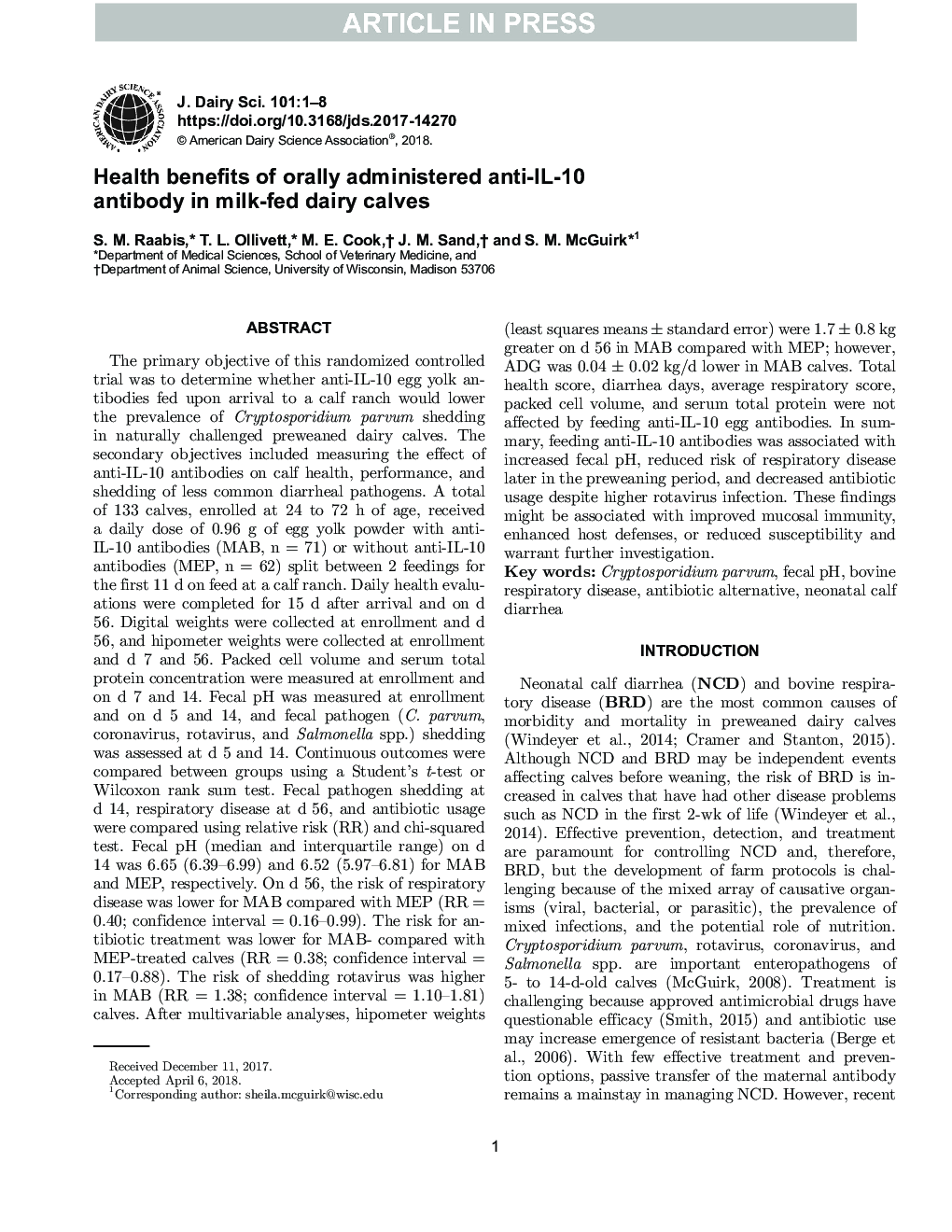| کد مقاله | کد نشریه | سال انتشار | مقاله انگلیسی | نسخه تمام متن |
|---|---|---|---|---|
| 8500940 | 1553837 | 2018 | 8 صفحه PDF | دانلود رایگان |
عنوان انگلیسی مقاله ISI
Health benefits of orally administered anti-IL-10 antibody in milk-fed dairy calves
دانلود مقاله + سفارش ترجمه
دانلود مقاله ISI انگلیسی
رایگان برای ایرانیان
کلمات کلیدی
موضوعات مرتبط
علوم زیستی و بیوفناوری
علوم کشاورزی و بیولوژیک
علوم دامی و جانورشناسی
پیش نمایش صفحه اول مقاله

چکیده انگلیسی
The primary objective of this randomized controlled trial was to determine whether anti-IL-10 egg yolk antibodies fed upon arrival to a calf ranch would lower the prevalence of Cryptosporidium parvum shedding in naturally challenged preweaned dairy calves. The secondary objectives included measuring the effect of anti-IL-10 antibodies on calf health, performance, and shedding of less common diarrheal pathogens. A total of 133 calves, enrolled at 24 to 72 h of age, received a daily dose of 0.96 g of egg yolk powder with anti-IL-10 antibodies (MAB, n = 71) or without anti-IL-10 antibodies (MEP, n = 62) split between 2 feedings for the first 11 d on feed at a calf ranch. Daily health evaluations were completed for 15 d after arrival and on d 56. Digital weights were collected at enrollment and d 56, and hipometer weights were collected at enrollment and d 7 and 56. Packed cell volume and serum total protein concentration were measured at enrollment and on d 7 and 14. Fecal pH was measured at enrollment and on d 5 and 14, and fecal pathogen (C. parvum, coronavirus, rotavirus, and Salmonella spp.) shedding was assessed at d 5 and 14. Continuous outcomes were compared between groups using a Student's t-test or Wilcoxon rank sum test. Fecal pathogen shedding at d 14, respiratory disease at d 56, and antibiotic usage were compared using relative risk (RR) and chi-squared test. Fecal pH (median and interquartile range) on d 14 was 6.65 (6.39-6.99) and 6.52 (5.97-6.81) for MAB and MEP, respectively. On d 56, the risk of respiratory disease was lower for MAB compared with MEP (RR = 0.40; confidence interval = 0.16-0.99). The risk for antibiotic treatment was lower for MAB- compared with MEP-treated calves (RR = 0.38; confidence interval = 0.17-0.88). The risk of shedding rotavirus was higher in MAB (RR = 1.38; confidence interval = 1.10-1.81) calves. After multivariable analyses, hipometer weights (least squares means ± standard error) were 1.7 ± 0.8 kg greater on d 56 in MAB compared with MEP; however, ADG was 0.04 ± 0.02 kg/d lower in MAB calves. Total health score, diarrhea days, average respiratory score, packed cell volume, and serum total protein were not affected by feeding anti-IL-10 egg antibodies. In summary, feeding anti-IL-10 antibodies was associated with increased fecal pH, reduced risk of respiratory disease later in the preweaning period, and decreased antibiotic usage despite higher rotavirus infection. These findings might be associated with improved mucosal immunity, enhanced host defenses, or reduced susceptibility and warrant further investigation.
ناشر
Database: Elsevier - ScienceDirect (ساینس دایرکت)
Journal: Journal of Dairy Science - Volume 101, Issue 8, August 2018, Pages 7375-7382
Journal: Journal of Dairy Science - Volume 101, Issue 8, August 2018, Pages 7375-7382
نویسندگان
S.M. Raabis, T.L. Ollivett, M.E. Cook, J.M. Sand, S.M. McGuirk,